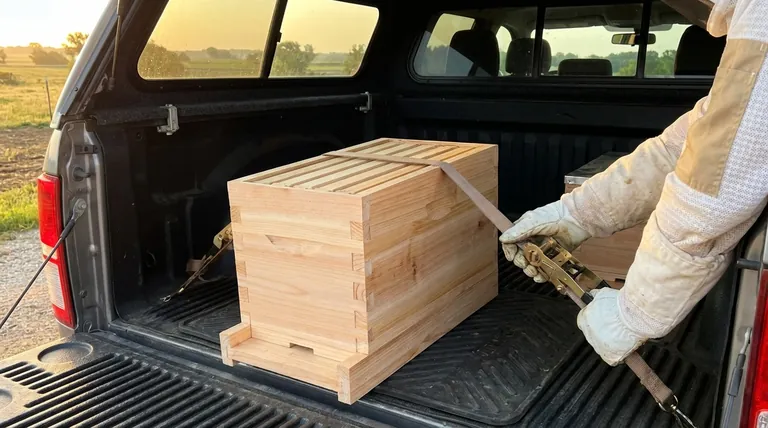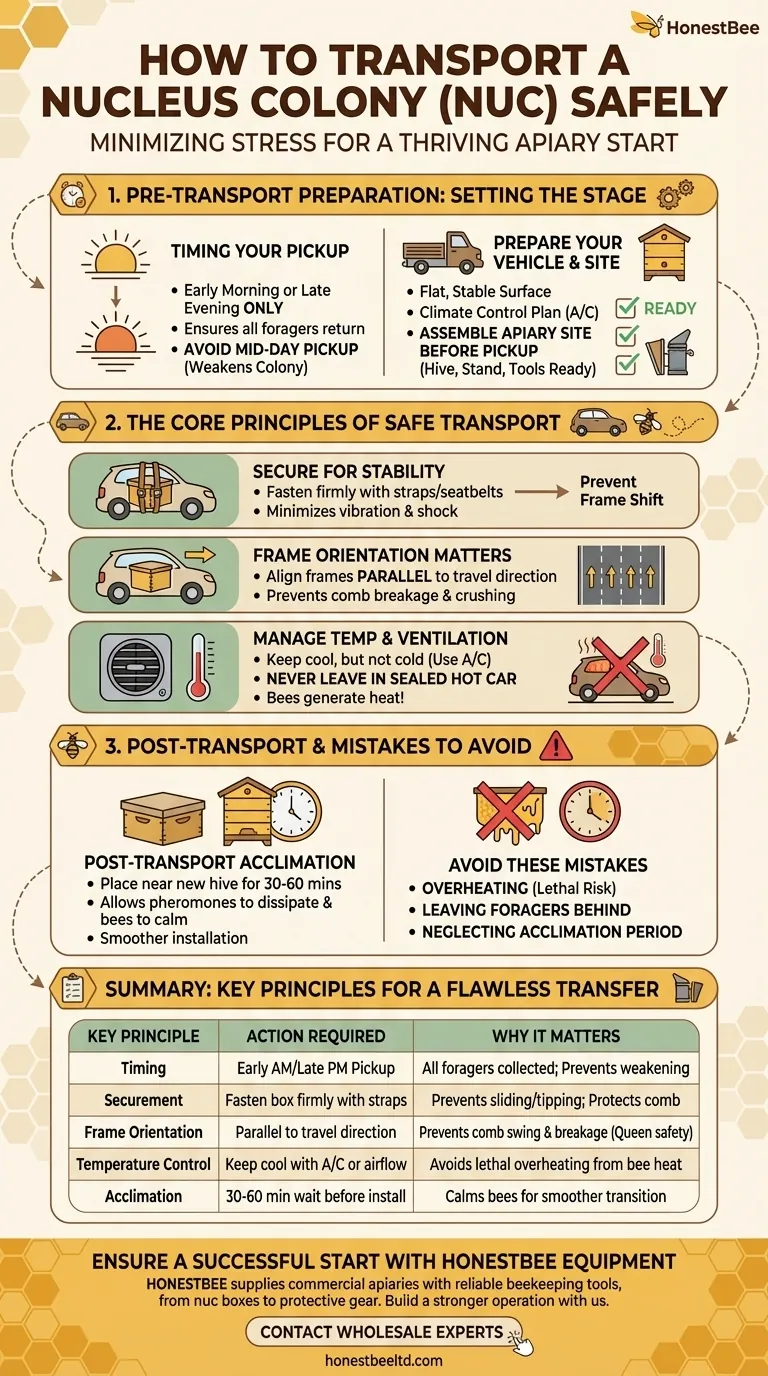To transport a nucleus colony (nuc) safely, you must secure it firmly within your vehicle, orient the frames parallel to the direction of travel, and ensure it remains cool but not cold. Timing is also critical; the nuc should be picked up early in the morning or late in the evening when all the foraging bees have returned to the hive.
The goal of transport is not just to move the bees, but to minimize colony-wide stress. A successful transfer is a three-part process: preparing your apiary before pickup, executing a smooth and stable drive, and allowing the bees a moment to settle before installation.

Pre-Transport Preparation: Setting the Stage
A calm and successful transport begins long before you start your engine. Proper preparation eliminates frantic last-minute work, which is a primary source of stress for both the beekeeper and the bees.
Timing Your Pickup
It is essential to pick up your nuc either early in the morning before the bees begin flying or late in the evening after they have all returned.
Picking up a nuc mid-day means thousands of forager bees will be left behind at the original location, permanently weakening your new colony.
Preparing Your Vehicle
Your vehicle should have a flat, stable surface for the nuc, such as the floor or a truck bed. Clear the area to prevent objects from sliding into the nuc box during transit.
Plan for climate control. Bees generate a significant amount of heat, and a sealed nuc in a hot car can quickly overheat and perish. Be prepared to use your car's air conditioning.
Assembling Your Apiary Site
Your permanent hive equipment—including the hive stand, bottom board, hive bodies, and covers—should be fully assembled and placed in its final location before you leave to get the bees.
Arriving with the nuc and then having to assemble its new home creates unnecessary delay and disturbance, increasing the risk of a stressful installation. Have your hive tool, smoker, and protective gear ready as well.
The Core Principles of Safe Nuc Transport
During the actual drive, your focus shifts to stability and environmental control. The bees are in a vulnerable state, and your actions directly impact their well-being.
Securing the Nuc for Stability
The nuc box must be securely fastened to prevent it from sliding, tipping, or vibrating excessively. Use ratchet straps or seatbelts to hold it firmly in place.
Every sudden stop, start, or turn sends a shockwave through the colony. Minimizing movement reduces bee stress and prevents the frames from shifting and crushing bees.
The Critical Role of Frame Orientation
The frames inside the nuc must be oriented parallel to the direction of travel, like lanes on a highway. The front of the frames should face the front of the car.
If frames are perpendicular to travel, a sudden stop can cause the heavy honeycomb to swing like a pendulum, breaking off the frame and crushing bees—potentially even the queen. Proper orientation provides the greatest stability for the comb.
Managing Temperature and Ventilation
While driving, ensure the nuc has adequate ventilation and is kept cool but not cold. A temperature-controlled car cabin is ideal.
Never leave a nuc in a sealed, parked car, as the internal temperature can rise to lethal levels in minutes. If you must stop, park in the shade and ensure airflow. The heat generated by thousands of bees is substantial.
Understanding the Trade-offs: Common Mistakes to Avoid
Even with the best intentions, simple mistakes can jeopardize a new colony. Understanding these pitfalls is key to ensuring the bees arrive healthy and ready to thrive.
The Danger of Overheating
Overheating is the single greatest risk during transport. A stressed, confined colony generates immense heat. Without ventilation, the wax comb can soften and collapse, drowning the bees and brood in honey.
Leaving Foragers Behind
The consequence of a mid-day pickup is a significant and permanent loss of your colony's workforce. The field bees will return to an empty spot, and your nuc will start with a major disadvantage.
Neglecting Post-Transport Acclimation
Once you arrive, do not immediately open and install the nuc. Place the nuc box on top of or directly beside its new permanent hive for at least 30-60 minutes.
This allows the colony's defensive pheromones to dissipate and gives the bees time to reorient and calm down, resulting in a much smoother and gentler installation into the full-sized hive.
Making the Right Choice for a Flawless Transfer
Your approach to transport should align with the primary goal: establishing a strong, healthy colony.
- If your primary focus is maximizing bee population: The single most important factor is timing your pickup for early morning or late evening to ensure no forager bees are left behind.
- If your primary focus is protecting the queen and brood: The critical action is orienting the frames parallel to travel and securing the box tightly to prevent comb damage.
- If your primary focus is reducing overall colony stress: Treat the transfer as a complete process, from having the hive stand ready before you leave to allowing the bees a quiet acclimation period upon arrival.
A calm, methodical, and well-prepared transport sets the foundation for your colony's future success.
Summary Table:
| Key Principle | Action Required | Why It Matters |
|---|---|---|
| Timing | Pick up early morning or late evening. | Ensures all forager bees are in the nuc, preventing permanent colony weakening. |
| Securement | Fasten nuc box firmly with straps/seatbelts. | Prevents sliding and tipping, which stresses bees and can damage comb. |
| Frame Orientation | Align frames parallel to the direction of travel. | Prevents comb from swinging and breaking during sudden stops, protecting the queen and brood. |
| Temperature Control | Keep the nuc cool with ventilation or A/C. | Avoids lethal overheating from the bees' own collective body heat. |
| Acclimation | Let the nuc sit by the new hive for 30-60 mins before installation. | Allows bees to calm down, resulting in a smoother, less stressful transition. |
Ensure a Successful Start for Your Apiary with the Right Equipment
A smooth transport is just the first step. A thriving colony depends on high-quality, durable beekeeping supplies. HONESTBEE supplies commercial apiaries and beekeeping equipment distributors with the reliable tools needed for success, from nuc boxes and hive components to protective gear.
Let us help you build a stronger operation. Contact our wholesale experts today to discuss your equipment needs and ensure your bees have the best foundation.
Visual Guide

Related Products
- 5 Frame Wooden Nuc Box for Beekeeping
- Plastic Transporting Bee Packages and Nuc Boxes for Beekeeping
- Twin Queen Styrofoam Honey Bee Nucs Mating and Breeding Box
- Automatic Heat Preservation 6 Frame Pro Nuc Box for Honey Bee Queen Mating
- Portable Bee Mating Hive Boxes Mini Mating Nucs 8 Frames for Queen Rearing
People Also Ask
- What frames should be moved into the queenless hive when requeening with a nuc? Ensure a Successful Queen Introduction
- What is the most common type of standard nuc? The 5-Frame Nuc Explained
- What is the purpose of having a nuc in beekeeping? Build a Resilient & Productive Apiary
- What are the benefits of starting a new bee colony in a nuc box? Boost Colony Success with Efficient Beekeeping
- What are the benefits of using nucs for beginning beekeepers? Ensure a Successful First Hive with a Head Start



















